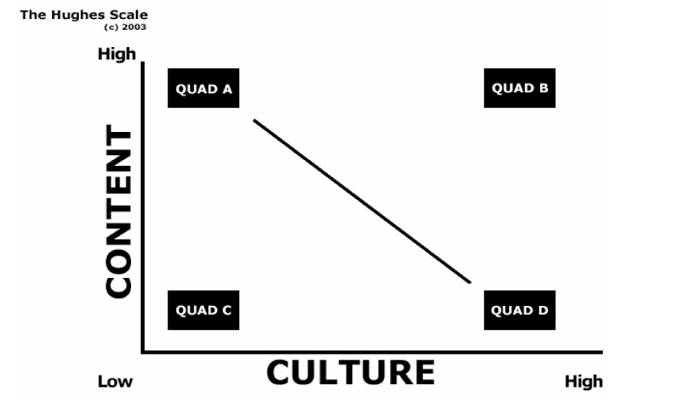“The gospel never fits properly within a culture.”
That is a quote by Ed Stetzer from a chapter in The Mission of Today’s Church. In the chapter, Stetzer is detailing the plight of Southern Baptist churches in relation to the North American mission field. He goes on to say, “Two parallel problems keep many believers from truly engaging the unchurched culture. Christians tend to love or despise the culture too much.” (152).
Stetzer is onto something here, and it would do us well to take note. For as long as I can remember, churches have seemed to fall somewhere on a spectrum of trendiness. Some churches are total sticks in the mud. Changing the carpet color in the sanctuary is just shy of heresy, and they have split over less. Other churches seem to try so hard to be cool. They are the high school cafeteria equivalent of the guy doing the quarterback’s homework so he can sit at the cool kid’s table. These churches try to look trendy, dress trendy, sing trendy, and preach trendy, and they will do anything (read change anything) in order to appeal to the masses.
So, which one is right? Is there not a better option?
Stetzer says yes, and he is right. In this same chapter, Stetzer references a tool I have found tremendously helpful through the years concerning the question of contextualization in North America. It is called the Hughes Scale. Robert Don Hughes developed a scale to measure churches regarding contextualization. From his perspective, churches tend to fall somewhere along an age-old perspective of either being “biblically faithful” or “culturally relevant.”
Of course, both sides of the spectrum look at the other with disdain, and certainly it is possible to fall off the rails in either direction. Some churches equate their hymn selection to the gospel and are unwilling to let go of it in order to reach the world around them, while other churches are willing to give up anything (even the gospel) if they think it will help them pack the seats. If your church is at one end of this spectrum, it most likely preaches against the other side.
This is why the Hughes Scale is so helpful. He breaks these ideas down into quadrants, and any church can evaluate themselves based on his graph. According to the graph, churches can fall into one of four categories. You most likely know churches in each.

Quadrant C
Churches in this quadrant are easily recognizable. They have low regard for content and low regard for context. Simply put, they do not care about biblical faithfulness or cultural relevance. These churches are most likely dead. Stetzer points out that you see their buildings, relics from a bygone era, with a small huddle of people who keep the lights on. For most of us, our concern is with the next two quadrants.
Quadrant A
Many conservative churches find themselves in this corner of the graph. They pride themselves on biblical faithfulness, and rightly so. They place a high value on the word and making sure they obey its teachings. However, despite a high value placed on content, they have a low respect for context. Without a healthy understanding of the context where they are planted, these churches do not have the tools necessary to speak in a way that makes sense to their community. This results in a church that says the right things, despite the fact that no one is listening.
These churches often come in one of two stripes. First, many simply have a lack of awareness. These churches mean well and would desire to speak to the unchurched, but they have not labored to understand the world around them. They could be clueless to the fact that things have changed, or maybe they are too focused internally to realize it. The second category willfully rejects contextualization as wrong. These churches have a strong separatist streak, and they see any move to make sense to the culture as acquiescence to the evils outside their door.
Quadrant D
On the other side of the aisle is the exact opposite problem. These churches are keyed into the context, but they are weak on content. Again, there are perhaps two reasons for this. Some churches simply lack theological depth. These churches are all about “reaching people,” but if you pinned them down and ask what that meant, they might not be able to tell you. Of course, if the leadership has no clue how to be a student of the word, then the congregation will follow that path.
On the other hand, there are a number of churches who know what the Bible says but see it and the culture as mutually exclusive. In other words, they feel the Bible itself must be reworded or reinterpreted for it to reach people today. Much theological liberalism is birthed from a desire to contextualize the message of the Bible. These churches wind up removing things like blood sacrifice, the atonement, the inerrancy of the Scriptures, and other elements of Biblical faithfulness, because they see them as stumbling blocks to the culture.
Quadrant B
Of course most (at least I hope most) evangelical churches live somewhere between the two extremes mentioned above. Every church varies concerning understanding of content and context, but all churches should strive to be in this last quadrant. Healthy churches excel at biblical faithfulness and cultural relevance. This, of course, means focusing on both. Churches in quadrant D do not see relevance to the culture and biblical fidelity as mutually exclusive. To the contrary, healthy churches understand the Scriptures were first written to a context, to be interpreted in contexts, and that they are only faithful to the text if they can interpret accurately in this contemporary context.
These churches have theological depth and cultural acumen. These churches are rare, but they should be the model for which we all strive.
Which quadrant?
So, the question remains. Where would you place your church? Hopefully, your church is biblically faithful. Does it pay attention to the unchurched context it hopes to reach? How much effort does your church put into being missional? If you wonder what that even looks like, check out this post on How to Know if You Church is Missional.





